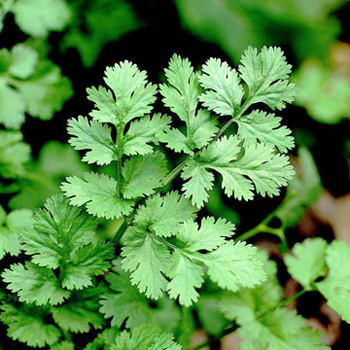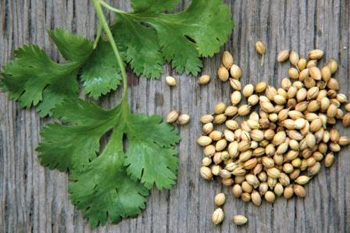|
||||||
CorianderScientific Names
Common Names
Parts Usually UsedSeed, leaves
Description of Plant(s) and CultureCoriander is a small, erect, shining annual plant; the round, finely grooved stem grows 1-2 feet high from a thin, spindle-shaped root. The leaves are pinnately decompound, the lower ones cleft and lobed, the upper finely dissected. From June to August the white to reddish flowers appear flat, compound umbels of 3-5 rays. The brownish, globose seeds have a disagreeable smell until they ripen, when they take on their spicy aroma. The seeds are hard and egg-shaped, borne in pairs which do not separate. Where FoundCultivated for thousands of years and is still grown in North and South America, Europe, and the Mediterranean area. Grows as a weed, especially in eastern and southern areas of the United States. Native to Mediterranean Europe. Medicinal PropertiesAlterative, antispasmodic, appetizer, aromatic, carminative, stomachic, pungent, cordial, diuretic, diaphoretic, diuretic, stimulant Biochemical InformationEssential oil which consists of a linalol called coriandrol (60-70%), geraniol, borneol and terpenes. Legends, Myths and StoriesCoriander is one of the basic ingredients in Indian curry, along with turmeric and cumin seed. One of the most ancient herbs still in use today. Coriander is known to have been cultivated in the Egyptian gardens thousands of years before the birth of Christ. The seeds were among the funeral offerings found in Egyptian tombs. It spread early to Western civilizations; the great Greek physician Hippocrates used it in the 5th century BC. Humans have consumed cilantro for at least 8,000 years. It was even found in the tomb of King Tutankhamen. By the time the herb had reached the Chinese continent, it had acquired a reputation for bestowing immortality and the Chinese herbalists developed several coriander compounds to that end. There are several Old Testament references to coriander as an herb whose fruit is similar to the mysterious food, manna, that God showered upon the Israelites during their desert trek from bondage. It is said that in parts of South America people are so fond of coriander flavor, the seeds are put into practically all their dishes. Italians use the seed in pizzas, polentas, bologna, ground and spice meat, and sauces. East Indians love the flavor in their curries and certain native dishes. Coriander seeds are used to flavor gin, whiskey, liqueurs, wine and brandies. An 1878 cook book advises roasting coriander seeds for culinary purposes. The Domestic Encyclopaedia (1802) states: “coriander seeds are used in bitter infusions and preparations with senna to overcome their disagreeable tastes.” Coriander seeds are like tiny balls, the green seeds have a disagreeable scent, but upon drying they become very fragrant. Its generic name is derived from a Greek work, koris, that means “bug”. The ancient Pliny described coriander as “a very stinkinge herb”. UsesCoriander can be applied externally for rheumatism, and painful joints. It improves the flavor of other medicinal preparations and stimulates the appetite. Used to treat diarrhea and colic, also cystitis, urticaria, rash, burns, sore throat, vomiting, indigestion, allergies, hay fever. A good stomach tonic and very strengthening to the heart. Will stop gripping caused by laxatives and expel wind from the bowels. At one time it was considered to have aphrodisiac effects. Used to flavor bread and liqueurs. Has the reputation to repel aphids. Formulas or DosagesInfusion: steep 2 tsp. dried seeds in 1 cup water. Take 1 cup a day. Powder: take 1/4 to 1/2 tsp. at a time. Nutrient ContentVitamin C How SoldCapsules WarningIt is safer to use cultivated plants, since wild plants may be mistaken for poisonous relatives. Resource LinksNew Research Tells Why Cilantro Helps Delay Seizures Bibliography
Herbal Gardening, compiled by The Robison York State Herb Garden, Cornell Plantations, Matthaei Botanical Gardens of the University of Michigan, University of California Botanical Garden, Berkeley., Pantheon Books, Knopf Publishing Group, New York, 1994, first edition
|
||||||
|
Copyright © 1996-2024 Medicinal Herb Info - All Rights Reserved
Powered by WordPress & Atahualpa |
||||||



 The Magic of Herbs
The Magic of Herbs